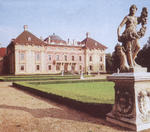 Mohyla Miru, 664 58 Prace u Brna, phone: 05/44 228 029
Mohyla Miru, 664 58 Prace u Brna, phone: 05/44 228 029
Slavkov near Brno is another name for Austerlitz, world-known as the battlefield where Napoleon defeated the combined armies of the Russian and Austrian Empires on December 2, 1805. The Baroque chateau seen here was mainly the work of Italians. It was designed by the Lucca architect, Domenico Martinelli; the sculpture was mostly the work of Goivanni Giuliani; the interiors, as well as the frescos and plaster work, were done by Andrey Lanzani and Santino Bussi. Beginning at the turn of the 18th century, the chateau was over 60 years in the making.
The paintings of the central hall and the chapel, dating from the 1760's, are the work of Josef Pichler. The chateau includes a gallery of paintings, inherited from the 17th and 18th century collection of the Kounic family, and a historical museum with a permanent exhibition on the theme of the Battle of Austerlitz.
Austerlitz (Mound of Peace). The memorial has been erected at the site of the bloody "battle of three emperors" which took place on the 2nd of December, 1805 near Slavkov, better known in Europe under the German name Austerlitz. Here, the French emperor Napoleon Bonaparte defeated the numerically superior Austrian-Prussian army led by the Austrian emperor Franz II. and the Russian czar Alexander I. All combating parties signed a truce at the castle of Slavkov on 6th of December. The Mound of Peace in Praka on the Slavkov battlefield was built according to the project drafted by J. Fanta during 1910 - 1911.
The Secession monument dedicated to the Slavkov's battle victims was built according to a project of architect Josef Fanta on the Pracky hill to the south of village Prace between 1909 - 1912. Adjacent to the monument there is a museum with an exposition of the course of the battle.
The town of Slavkov u Brna entered the annals of history through a Napoleonic Battle, and its castle has occupied an important place in the history of Central European Art, with its architectural value and its artistic setting. The current town settlement was created at the crossing of the long-past merchant routes leading from Brno over to Bucovice, Hodonin, and Vyskov. The monarchs domain was, at the turn of the 12th century, given to the 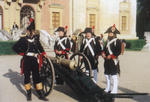 Order of German Knights, which built a fortress here. Eleven commanders took turns, until it was confiscated by the Czech king, Sigismond of Luxembourg, in 1420's. Due to its agricultural background, it ranked among the wealthiest estates of the order in the Czech Kingdom. The developing settlement around the castle was given its own township and coat of arms by King Wenceslas IV., and today it has the privilege of being the oldest remaining coat of arms in the Czech Republic.
Order of German Knights, which built a fortress here. Eleven commanders took turns, until it was confiscated by the Czech king, Sigismond of Luxembourg, in 1420's. Due to its agricultural background, it ranked among the wealthiest estates of the order in the Czech Kingdom. The developing settlement around the castle was given its own township and coat of arms by King Wenceslas IV., and today it has the privilege of being the oldest remaining coat of arms in the Czech Republic.
The face of the town changed at the end of the 16th and the beginning of the 17th century. The original Gothic housing was replaced by the renaissance style, which is still noticeable in some buildings today, particularly in the center square, in portals, and in the entrances of "Mazhauzes" (translators note: a large parlor found in Medieval buildings), which have arched ceilings formed by barrel and cross vaults.
For almost one century, Slavkov was a refuge for German Anabaptists who were famed for their so-called Haban Ceramics. They contributed greatly to the economic prosperity of the town and its urbanization, and they were also living proof of the religious tolerance of the owners of the Slavkov Estate of that day. The core of the town was still enclosed by a late Gothic wall structure that had four gateways, and the inner settlement was formed by a large Jewish community in addition to the predominant Czech population.
During the Baroque period, an exquisite three-winged chateau was built according to plans by the architect Domenico Martinelli of Lucca (1650-1718), which was constructed in three stages, replacing already standing houses, and was completed under the rule of Duke Vaclav Kounic-Rietberg, in 1769. It took more than 60 years to build it, and this fact is significantly manifested by the richness of its interiors, which reflect the Italian concept of the chateau lifestyle from the early Baroque period through classicism. The social and political ambitions of the Kounic family managed, due to their exquisite artistic taste, to convert the Slavkov Chateau in the mid-18th century into a center for the presentation of Central European Flemish and Italian school paintings, which resulted in this gallery becoming one of the most popular and wealthiest in Europe at that time. However, the collection was severely damaged in the course of the Napoleonic Wars and during a fire in the Chateau in 1897. The Chateau is still open to the public, so visitors may still witness some of the excellent Central European paintings from the 17th and 18th century.
However, the Baroque period deprived Slavkov of the northern town gateway, the Gothic cathedral of St. Jacob the Elder, and the Belfry, which were all sacrificed for the extension of the Manor Park. A classicist parish church, the Resurrection of the Lord, was then built, but the marshy lands prevented the planned twin towers from being built. The town housing was sensitively incorporated into the landscape through the use of axial avenues, which remarkably still comprise the urban structure of the town.
The Kounic family mausoleum, which is beneath the little church of St. John the Baptist at Spitalka, proves how important the town was for this aristocratic family, whose lineage survived in the town for 410 years. The personality of the State and Conference Minister, Vaclav Antonin Dominik - the Duke Kounic-Rietberg (1711-1794), brought representatives of the Habsburg ruling family to the Chateau and contributed to the town's visibility in the Central European region. The stay of French Emperor Napoleon Bonaparte I at the Chateau in 1805 and his proclamation after winning the Battle at Slavkov made Slavkov, at that time still called Austerlitz, well known throughout the entire cultural world.
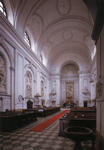
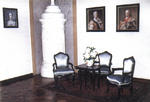
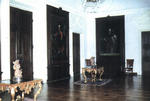
 Guide
Guide 





